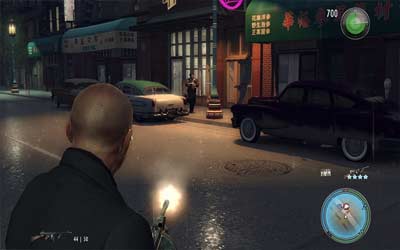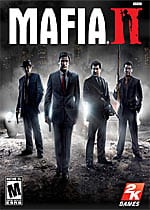Style Over Substance
Mafia II is a game that is full of surprises. When I first had the opportunity to check out Mafia II in 2009, I was amazed that I had never heard of its predecessor. The premise in the original was simple and followed the story of a lone gangster trying to make his way in the world.

With a decent story and an open world reminiscent of Grand Theft Auto III, there seemed to be quite a lot going for the original Mafia. However, it is important to point out immediately that Mafia II has made a fundamental break with the expectations fans of the first game may have had. While games from the same time period like the GTA series have evolved into sprawling open-world epics, Mafia II has stayed focused on the story-driven experience that hallmarked the original game.
While Mafia II is technically set in an open world, the game moves along in a linear fashion. There are no real side-missions in the game other than the few collection missions that permeate your menus (but are not part of the game’s story). Once you finish a mission, your routine entails going back to your pad, sleeping it off, and then immediately getting another mission. This type of linear gameplay was a little jarring for me at first, as I was expecting much more freedom within the world of Mafia II. Though you can jump in a jacked car and ride around the Empire Cityscape for hours, there is nothing to do around the city, and eventually that one red dot that indicates your next mission will be visited. The lack of a truly open world with side missions and character-developing opportunities is regrettable and makes Mafia II seem like a disappointment right off the bat.
However, after playing Mafia II for awhile, I began to have a change of heart. Though the lack of extra things to do certainly made the transition from mission to mission feel monotonous, I began to care less about what I was (or was not, in this case) able to do in the game, and became more immersed in the story of Mafia II. The game’s plot follows the story of young Vito Scaletta who has just returned from fighting in World War 2. Vito has found his family life in shambles, as his mother and sister are living in some pretty cruddy quarters, and are being harassed by loan sharks and thugs for a debt that Vito’s late father left behind. Of course, Vito’s family wants him to go get a regular job moving crates for $10 a day, but Vito quickly realizes that he’ll have to do something else in order to get the money his family so desperately needs. However, nothing is free, and Vito’s rise to glory within the Italian Mafia does not come without a high cost. As a sucker for gangster movies, I have to say that a lot of the tropes and themes in Mafia II were instantly recognizable, which could be considered a good or a bad thing. On one hand, I appreciated the familiarity of the story, but I couldn’t help wishing they had pushed the envelope a little more, instead of retreading the same old ground as the Godfather series. Still, there were enough twists and turns in the plot to keep me playing, and at the end of the day, that fact alone counts for a lot.

Still, even though the story was quite engrossing, that doesn’t mean that the gameplay was without its problems. One huge issue that was a constant problem in Mafia II was the amount of travel required between missions. While it is perfectly permissible to spend several minutes travelling in a game, the amount of driving that is required of players in Mafia II between missions is a little exorbitant. I would routinely spend ten minutes or more just driving around to missions that would only take five minutes or less to complete. Although driving around in the game’s fifty plus vintage cars is certainly fun, the egregious amount of driving you have to do between missions really lessens the immersion factor and can make the gameplay feel claustrophobic at times.
The focus on driving around is especially disheartening, as it detracts from the game’s amazing setting. The world of Empire City is clearly based on New York in the 1940s and 50s, and comes complete with wise-cracking locals, classic clothes, and a certain vintage sensibility. The game goes to amazing lengths to present this world in a believable way, and it works most of the time. Most of us weren’t alive during this time period, but everything seems so natural in Mafia II that it’s almost like recalling a memory you never had.
In addition to the game’s extremely detailed environments, the game’s immersion is also helped along quite substantially by the presence of a killer soundtrack. Although the driving itself can get quite boring, the game features several in-game radio stations you can listen to, which will play back plenty of “old” hits from the 1940s and 50s sandwiched in between bits of dialog that describe everything from the latest police reports to the current strategy for winning the war.

Mafia II also features a beautiful orchestral soundtrack that plays during pivotal cutscenes. No matter whether you prefer the game’s terrific score or its collection of “golden oldies,” listening to Mafia II’s music is a dream. The voice actors for the main characters also deserve a mention here, as they do an excellent job of bringing these larger-than-life mobsters to life in a way that was both subtle and believable.
As far as play time is concerned, Mafia II has about a ten hour story mode, which can be extended by maybe an hour or two if you decide to do the Playboy cover collection quest. The game is fairly short when you compare it to other open-world style games, but when you take into context the game’s strong focus on storytelling, it seems about right. Multiple playthroughs don’t seem likely with Mafia II, and after the game is complete, there is no post-game content to explore in Mafia’s expansive, but somewhat empty, world.
Though Mafia II was initially viewed as a game to rival open world games like Red Dead Redemption and Grand Theft Auto, in reality, it is a game that is all about a linear, plot-driven, single-player experience – with a lot of open world driving. If you are not a fan of this type of gameplay experience, Mafia II will not be an enjoyable title for you. However, if you like games that take the time to present you with a detailed story that is told in a very rigid sequence, this title will certainly be worth your time. Though I would have liked to have seen more of Empire City and would have relished more exploration options, the story presented in Mafia II made the overall experience worthwhile. Mafia II is not a game for everyone, but it certainly fulfills expectations for its target audience.
RATING OUT OF 5 RATING DESCRIPTION 3.8 Graphics
The character models look great, and the detailed environment of Empire City feels like a living, breathing city. 3.9 Control
The controls are easy to use, shooting feels natural, and handling behind the wheel is nicely varied. 4.5 Music / Sound FX / Voice Acting
The voiceover in Mafia II is pitch-perfect, and the soundtrack is a nice mix of orchestral background music and period tunes. 3.9 Play Value
The game isn’t particularly long, and the lack of substantial side-missions hurts this game’s replay ability overall. Still, the story mode experience is good enough that the time you do spend with Mafia II is well-spent. 4.0 Overall Rating – Great
Not an average. See Rating legend above for a final score breakdown.
Game Features:
